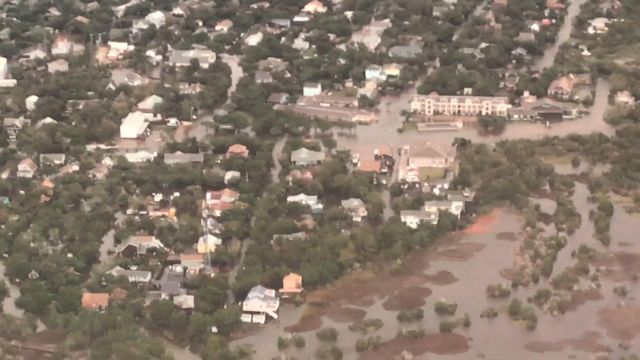Dorian's floodwaters trap people in attics on Ocracoke Island
A weakened Hurricane Dorian flooded homes on North Carolina's Outer Banks on Friday with a ferocity that took even storm-hardened residents by surprise, forcing people to retreat to their attics. Hundreds were feared trapped by high water.
The Hyde County Sheriff's Office sent medics and other rescuers to Ocracoke Island — accessible only by boat or air — to reach those who made the mistake of defying mandatory evacuation orders along the 200-mile ribbon of low-lying islands that stick out from the Eastern Seaboard like the side-view mirror on a car.
"There is significant concern about hundreds of people trapped on Ocracoke Island," Gov. Roy Cooper said. "There are rescue teams ready as soon as they can get in."
Cooper said an estimated 800 people rode out the storm on the island.
The North Carolina National Guard and the U.S. Coast Guard landed four Blackhawk helicopters on an island baseball field, where people quickly unloaded boxes of supplies. A 79-year-old man rode one of the helicopters back to the mainland because he needed medical care, and officials said others with medical needs could be airlifted off the island.
Residents also could be moved to a shelter in Washington County, Cooper said.
Ferry service to the island could be restored as early as Saturday to help speed the response and recovery effort, Secretary of Transportation Jim Trogdon said.
Its winds down to 90 mph, Dorian howled over the Outer Banks as a far weaker storm than the brute that wreaked havoc on the Bahamas at the start of the week. But the Category 1 hurricane lashed communities with rain and surging seas, sending water coursing into the main floors of elevated homes.
Around midmorning, the eye of the storm came ashore at Cape Hatteras, Dorian's first landfall on the continental U.S.
"I am not going to lie, it was scary at the time," Ann Warner, who owns Howard's Pub on Ocracoke Island, told WRAL News by telephone on Friday afternoon after the storm had passed. "That water came up so fast out of nowhere. It was higher than [2016's Hurricane] Matthew, and we have experienced significant flooding."
Warner told The Associated Press that water "came up to the inside of our bottom floor, which has never had water," a skylight blew out, and there were whitecaps in her front yard and underneath her house.
"We're safe," she added. "But it's certainly a mess."
Another Ocracoke Island resident, bookshop owner Leslie Lanier, said via text message that the first floors of some homes had flooded and people had been forced to climb to their attics, but that the water had already begun to drop.
"We are flooding like crazy," she said, adding: "I have been here 32 years and not seen this."
Ocracoke Island resident and restaurant owner Jason Wells said the flooding was the worst he had ever seen or heard of.
"Several people were rescued from their upper floors or attics by boat by good Samaritans," Wells said in a text message. He said he wasn't aware of any serious injuries.
Scott McNally said both of his restaurants on the island were destroyed by the flooding. He said he's lived on the island for 25 years but had never seen such flooding.
"It came in quick," McNally told WRAL News by telephone. "It's up to my neck now. My Jeep's under water, the boat's floated off the trailer. ... It's not cool."
The Hyde County Sheriff's Office said deputies, medics and other rescuers were heading to the island amid reports of "catastrophic flooding." The governor said that authorities were telling people to get to the highest point in their homes.
In Buxton on Hatteras Island, close to where Dorian blew ashore, Radio Hatteras volunteer Mary Helen Goodloe-Murphy said that people were calling in to report that "houses are shaking like crazy" and that "it's never been like this before."
"The wind is blowing with fury," she said.
Danny Couch, a resident of nearby Buxton and a Dare County commissioner, said that the storm sent crab traps flying, breaking windshields.
"I was out there, and stuff flying around, road signs and stuff," he said. "It's crazy. I don't want to be a statistic."
He added: "It's godawful. It's a storm of record, no doubt."
Buxton resident Donnie Bowers noted how Dorian's winds pushed water in the Pamlico Sound away from the barrier islands and then shoved all of that water and more back into the islands, causing extensive flooding.
As of 5 p.m., Dorian was moving northeast at 24 mph. The center of the storm had pushed past the Outer Banks and was about 340 miles east-northeast of Raleigh.
It is expected to remain a hurricane as it sweeps up the Eastern Seaboard through Saturday, with tropical storm-force winds affecting Cape Cod late Friday and eastern Canada on Saturday.
More than 350,000 people were without electricity in the Carolinas and Virginia as Dorian moved up the coast.
At least four people were killed in the Southeast. All were men in Florida or North Carolina who died in falls or by electrocution while trimming trees, putting up storm shutters or otherwise getting ready for the hurricane.
More than a quarter-million residents and visitors had been ordered to evacuate the North Carolina island chain ahead of the storm, officials said.
But as Dorian closed in, many of the Outer Banks' residents tied down their boats, removed objects from their yards that could blow away, and hunkered down.
At the start of the week, Dorian slammed the Bahamas with 185 mph (295 kph) winds, killing at least 30 people and obliterating countless homes. From there, it swept past Florida and Georgia at a relatively safe distance, then sideswiped the Carolinas on Thursday, spinning off tornadoes that peeled away roofs and flipped recreational vehicles.
Still, the damage was far less than feared in many parts of the Carolinas, including historic Charleston, South Carolina, which is prone to flooding even from ordinary storms, and Wilmington, North Carolina, the state's biggest coastal city.
Joseph Pawlick went out Friday morning to rake leaves, twigs and other debris blown from the sidewalk outside his Wilmington home.
"I slept like a baby last night. This, thankfully, was not bad," he said.











